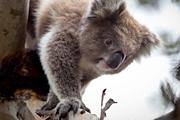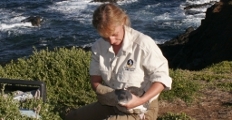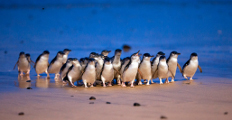Eastern barred bandicoot celebrates wild anniversary
The endangered Eastern Barred Bandicoot is thriving on Phillip Island, five years after they were introduced to the island safe haven and saved from extinction in the wild.
Since their release on Summerland Peninsula in 2017, the species has spread across the island with sightings as far as Wimbledon Heights, Pyramid Rock and Ventnor.
Last year, in a first for an Australian species, the mainland Eastern Barred Bandicoot was reclassified from ‘extinct in the wild’ to ‘endangered’. This was made possible in part after researchers from Phillip Island Nature Parks and the Eastern Barred Bandicoot Recovery Team relocated 67 bandicoots to Summerland Peninsula on the western tip of Phillip Island in 2017.
Recovery actions for the species that contributed to the 2021 ‘down-listing’ of the species have also occurred elsewhere across the state delivered under the guidance of the Eastern Barred Bandicoot Recovery Team.
Researchers estimate bandicoot numbers to now be in the hundreds on the island but can’t say for certain as it’s not possible to track every animal.
The Eastern Barred Bandicoot was first introduced to Churchill Island, which sits off Phillip Island, in 2015. Prior to their release on Churchill Island, the Eastern Barred Bandicoot had been largely wiped out on the mainland by foxes and a loss of habitat – only surviving within three reserves in Victoria surrounded by fox-proof fences.
Phillip Island Nature Parks Deputy Research Director Dr Duncan Sutherland said the translocation of the bandicoots to Phillip Island, which was declared fox-free in 2017, gave the marsupials the best chance of survival.
“We’d made this leap from having bandicoots in just a few tenuous reserves that were fenced from predators and here they are on this huge landscape of Phillip Island, which has had foxes eradicated from it and great opportunity for the species to be recovered,” he said.
“The Eastern Barred Bandicoots have now been on Phillip Island for five years and from there they’ve bred and grown in numbers. They haven’t actually increased in density much, but they’ve been spreading up to about 10km from the original release site, which indicates that they’re doing really well.
“As far as we know, it’s the only species in the world that has gone from ‘extinct in the wild’ to ‘endangered’ and no longer requiring a captive breeding program, so it’s quite a remarkable
achievement.”
Dr Sutherland said researchers had also been buoyed by community involvement, with locals keen to track progress and whereabouts of the bandicoots.
“It’s been wonderful to get reports from the locals who literally see them in their backyards,” he said.
“The community is an integral part of the research and monitoring that we do and without them it just wouldn’t be possible – we just wouldn’t have been able to bring back a species from the brink of extinction.”
He said feral, stray and domestic cats still posed a threat to the shy marsupial through predation and disease; and urged pet owners to act responsibly and always keep animals contained on their property to help protect the island’s significant wildlife.
The Eastern Barred Bandicoot Recovery Team has members from Conservation Volunteers Australia, Department of Environment, Land, Water and Planning (DELWP), National Trust of Australia, Parks Victoria, Phillip Island Nature Parks, the University of Melbourne, Tiverton Rothwell Partners and Zoos Victoria.





















